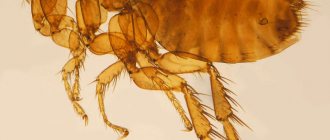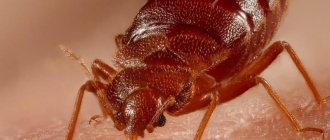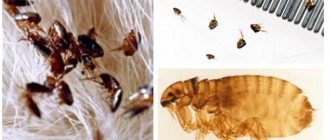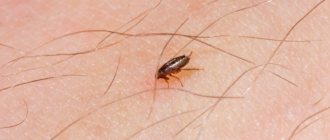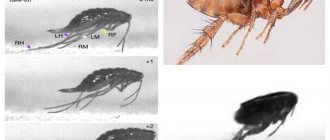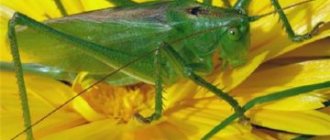How long do fleas live?
In favorable conditions for life, fleas live up to three months, during which the female lays approximately 500 eggs. The most comfortable conditions for parasites are a temperature of 21-26 degrees above zero, and a humidity of about 80%. When the temperature increases by 10 degrees, the development of fleas almost doubles. A decrease in temperature, on the contrary, leads to a slowdown in the growth of insects and an increase in life expectancy up to 2 years.
The reproduction cycle of insects also depends on the temperature regime. At optimal temperatures, the development period of the larvae is one month, at elevated temperatures - up to 10 days, at very low temperatures - up to 7 months. Then the eggs develop within 14 days; the insect remains at the pupal stage for about 20 days. In general, the full development cycle lasts from 10 days to one year, and life expectancy - from 1.5 months to several years.
What factors influence the lifespan of a flea?
All indicators are purely individual and depend on the type of parasite. It must be taken into account that when the temperature increases or decreases, fleas will not disappear, but will only speed up or slow down their usual life cycle
The following aspects are of utmost importance for the growth of parasites:
- Low air humidity;
- Constant access to prey for food;
- Constant environmental parameters without temperature fluctuations.
Keep in mind that fleas are common blood-sucking pests that multiply quickly. One individual lays an astonishing number of eggs and sometimes the infection of an apartment or pets reaches astonishing proportions. If no measures are taken, each flea will regularly feed on blood and produce offspring for three months. It is in your interests to get rid of the unwanted population in your apartment and on your pets as quickly as possible.
How long do fleas live without food?
Fleas can go without food for about 2-3 months; their bodies are adapted to living in unfavorable conditions and the absence of a food source. But fleas cannot go on without food indefinitely, because they need fresh blood to reproduce and lay eggs.
When leaving the apartment with your pet for a long time, you should not expect that the fleas will die without the animal; they will definitely wait for the cat or dog to arrive and bite them. A peculiarity of country fleas and other types of fleas is their ability to sometimes feed on the blood of rats and mice, so they can wait for a long time for the owner with their pet.
Centenarians
How long do fleas live? Among the bloodsuckers there are also long-livers. Insects that feed on ungulates are the largest representatives of the species, and they live the longest.
The life cycle of a flea parasitizing sheep is about a year, with such development of fleas their length can reach up to seven millimeters. Insects that live on northern animals are able to hibernate in winter and their life span can reach 1.5 years.
They do not live on humans; they also do not live permanently on mammals and do not live for long; they often change their owners. Bloodsuckers can only breed in quiet and safe places. They fall on people and animals only to feast on blood. The eating time of an individual ranges from one minute to two hours.
Since animals and people are only an island of food for bloodsuckers, where do these insidious insects live? Most often, parasites live in carpets, behind baseboards, on the floor, among old things and garbage, in a closet with clothes. Immediately their larvae are born. The main criterion for them when choosing a place to live is easy access to food, although they can exist for a long time without food.
Habitats of fleas in the apartment and in nature
In an apartment, dark and quiet places are suitable for insects to live:
- animal bedding;
- carpets;
- upholstery of sofas and armchairs;
- children's soft toys;
- old clothes;
- mattresses and bed linen;
- behind the baseboard and under the linoleum.
On the street, blood-sucking parasites choose places of residence with close proximity to animals that can provide them with a source of food (squirrels, rabbits, hamsters, rats, gophers, etc.). Places for living most often include garbage cans, sand heaps, basements, bird nests, and the burrows of some animals.
There are several types of domestic fleas that live in close proximity to humans:
- fleas of dogs and cats;
- mouse and rat;
- basement and ground;
- bed fleas;
- sandy.
Fleas are insects, although small, but they cause quite a lot of problems. Their bites are very painful and cause discomfort to the animal in the form of itching and irritation. In addition, these parasites are carriers of many unpleasant diseases. Therefore, it is important to get rid of them not only from pets in a timely manner, but also to remove them from all possible corners of the apartment.
Types of fleas, photos and names.
Currently, there are from 15 to 22 families of fleas, including many species:
Human flea (female on the left, male on the right)
(lat. Ctenocephalides felis) is found on all continents and is a carrier of plague, brucellosis and other infections. It feeds on the blood of cats, dogs, rodents, many other animals, as well as humans. Larval development occurs in animal fur and litter. The average size of a flea is 0.75-5 mm, the body length of a female with eggs reaches 1.6 cm. Adults have a short proboscis and a flat forehead. The lifespan of a cat flea ranges from 3 months to 3 years.
The southern rat flea (lat. Xenopsylla cheopis) is a particularly dangerous species of flea, a carrier of plague, mouse and rat tapeworms. It is found throughout the world, but to a greater extent in countries with tropical and subtropical climates. The female flea has a body length of 1.8 to 2.7 mm, males grow from 1.4 to 2 mm in length. The color of the flea can be light or dark brown. Fertilized females lay eggs in the nests of rats and gerbils - animals whose blood they feed on.
Soon after fertilization, the female flea is ready to lay eggs, which occur in small portions. A well-fed female lays 1-2 portions of 4-10 eggs per day, but usually laying occurs once a day or every other day. The process of laying eggs is interesting. The female flea forcefully pushes out the eggs, which are scattered at a considerable distance from each other, which also makes sense: the risk of competition between the hatched larvae is minimized, and most of them will survive, having enough food.
Fleas are insects with complete metamorphosis; their life cycle consists of several stages:
- egg,
- larva,
- doll,
- imago (adult).
Flea eggs are white and very small, looking like grains of rice under a microscope.
The development of flea eggs lasts about 14 days, after which translucent worm-like larvae, devoid of legs, are born, which, writhing, burrow into the litter of the host's nest. The larvae feed on rotting organic matter, desquamated skin epithelium, or the remains of undigested blood in the excrement of the parents.
After 3 molts, the flea larva turns into a pupa, surrounding itself with a strong silk-like cocoon. Depending on weather conditions, the pupal stage lasts from 5 days to several months. In many species of fleas, pupae overwinter, and in some, emergence from the cocoon is timed to coincide with a specific season.
An adult flea emerging from the pupa immediately begins searching for its owner. The active life of an imago lasts on average 1.5-2 months, but at sub-zero temperatures an adult flea can fall into a state of suspended animation for an indefinite period.
Methods for eliminating fleas in animals
Pets must be treated first. There are many means for these purposes.
Special shampoos . The product is applied to the pet’s fur while bathing, after 3-5 minutes it is washed off with clean water, then the animal must be thoroughly combed.
Sprays and drops are very effective in controlling fleas. The drops should be applied to the animal's skin along the ridge to prevent the drug from being licked off. The spray is applied to the entire coat by spraying.
Anti-flea collars are used not only to get rid of parasites, but also as a preventive measure. Biological or chemical flea collars for dogs and cats can be purchased at veterinary clinics or pharmacies.
Getting rid of fleas
If you use an integrated approach, you can fix the problem quite quickly. You need to act step by step.
Cleaning and tidying up the living space
It is necessary to pay attention to all surfaces and corners, spaces behind furniture. A mop, rags, and especially a powerful vacuum cleaner will help, since flea eggs can be found in cracks in the floor and other places where they cannot be swept out. In addition, you can use a broom to scatter the eggs around the room, rather than collecting them on a scoop. Retaining eggs after harvesting will provoke re-infestation. It would not be superfluous to add essential oil or flea shampoo to the water during wet treatment.
Washing bed linen
The best option is to wash at temperatures above 60 degrees and dry outdoors in the sun. After drying, the linen should be ironed.
Wardrobe check
The spread of insects in clothing cannot be ruled out. It should be treated with an iron or steam generator, and if possible, dry cleaned. When disinsection, clothes should be hidden in bags.
Pet care
Pet hair must be treated with a special preparation, one of which is BARS® drops for dogs and cats. The product provides maximum results with minimal toxicity. Dishes, tray, toys, bedding, etc. should be washed in very hot water.
Folk remedies against fleas in animals
- Treat your pet's fur with a solution containing essential oils of lavender and cedar (2 drops of oil per 500 ml of water). Spraying should be done daily for two weeks.
- Make a compress from a mixture of camphor alcohol, 3% acetic acid and regular cologne. Hold a plastic bag in the area of the cat's neck moistened with this solution. Then comb the coat well over a bowl of water.
- Dissolve regular table salt in warm water and keep the cat in it for about 10-15 minutes.
- Chop a couple of cloves of garlic and add half a glass of water, let it sit overnight, and rub the resulting solution into your pet’s skin.
- Combing the fur using baking soda; after the procedure, the animal must be washed.
- Treating the animal with lemon spray. Cut the lemon into several parts and boil in a liter of water. Leave the resulting liquid for 6-8 hours, strain and pour into a spray bottle.
After removing fleas from pets, it is necessary to carry out a general cleaning of all areas where parasites may live.
Where do parasites hide in the house?
To make insect control as effective as possible and quickly eliminate the problem, it is important to know which places need to be given more attention. Fleas can move throughout the home, but they usually concentrate in the areas where they are most comfortable.
- upholstered furniture, mattresses;
- bed linen, towels;
- carpets, rugs (especially with natural pile), linoleum;
- fur clothes;
- Stuffed Toys;
- cracks in the floor, baseboards;
- pet bedding;
- household waste;
- any other places where cleaning has not been carried out for a long time.
Typically, insects live no higher than 1–1.5 meters above floor level. Therefore, bites on humans are most often on the legs.
Room treatment
Today, the choice of products in stores to combat parasites is very large - you can find drugs in the form of aerosols, concentrated solutions, various powders and pencils.
Concentrates have the greatest effect and are low cost. One bottle of this product is enough to treat the entire apartment. However, the drugs are very toxic and have an unpleasant odor; the procedure must be carried out with gloves and glasses, in the absence of children and animals.
The most famous con, “Taran”, “Dobrokhim”, etc.
Aerosols in cylinders can be used to treat office and residential premises. They are not affordable for everyone, but they are very convenient and easy to use, and sometimes have a pleasant aroma.
The treatment should be carried out with the windows and doors closed; it is possible to ventilate the room 2 hours after the procedure.
The following brands are popular: “Raptor”, “Dichlorvos”, “Reid”, etc.
Powders and pencils : mainly used to remove flea larvae in places where they are most concentrated (basements, attics, cellars). They are low cost and have a good effect in getting rid of parasites.
You can purchase the following names: “Phenaxin”, “Tornado”, “Baygon”, etc.
If you are unable to cope with harmful insects on your own, you can use the services of a special service that will professionally help solve the problem quickly and reliably.
The preparations used by the services are highly toxic, so it is better to leave home for 2-3 days during treatment, and upon return, thoroughly wash the floors and wipe all surfaces with special products.
What do house fleas look like and how to spot them?
A flea is a small blood-sucking insect, the size of which does not exceed 3 mm. These parasites in appearance resemble very small, round and shiny plant seeds. The color of an adult insect is black or dark brown. All types of fleas differ in size, but these differences are very minor.
Almost every person who has a pet knows what adult fleas look like. However, few people have seen flea larvae. So, let's take a closer look at the insect's life cycle.
In its reproduction, a flea goes through a full cycle of successive transformations - adult insect, egg, larva, pupa, adult insect.
Flea eggs look like tiny white translucent balls. A single female can lay up to 30 eggs per day. After two weeks, larvae emerge from the eggs, resembling a small black worm. The worms move actively and live in dust, garbage or in the bedding of a pet. The larva then pupates and increases in size. Next, an adult flea emerges from the pupa.
Detecting fleas is very difficult. The determining factor is the presence of them on the pet. If there is neither a cat nor a dog in the house, then finding out where fleas live and whether they exist at all is quite difficult.
Lifespan
How long do fleas really live? On average, under ideal conditions, the lifespan of an adult flea is 3 months. During this period, the female manages to lay about 500 eggs, and the remaining insects will be able to leave about 60 bites on the body of their victim: animal or human. After this she dies naturally.
Ideal living conditions for parasites depend on air humidity and temperature. The lifespan of rat fleas is two months at a temperature of 14 degrees and a humidity of 60%. Parasites living in an apartment can live at the same temperature and air levels as rat fleas, unless, of course, they try to destroy them using special means
It is also important that the parasites are not left without food.
At high air temperatures, insects do not live long, about 4 weeks, and grow very large, but the development of eggs and larvae, under such conditions, proceeds faster, hence the reproduction stage is reduced.
At normal temperatures, larvae form in about a month, at high temperatures about 7 days. The eggs take fourteen days to develop, and the insect spends the same amount of time at the pupal stage.
Parasites do not live long, even under favorable conditions, since they are killed by the hosts themselves. Animals bite parasites out of their fur. Bloodsuckers also die from their own infections. But individual individuals can survive their owners, because after the death of the food source, the insects instantly leave the animal’s corpse and go in search of a new victim.
How to protect yourself
It has now become completely clear that fleas are transmitted from cats to humans, and this happens quite often. But you can protect yourself from infection if you follow some rules:
- Avoid close contact with stray animals. So do not pet stray cats or get close to them; fleas can quickly jump on you.
- If you have a pet, check its body regularly. But even such inspections will not be enough. If your pet goes outside, you should periodically treat it with specialized medications or, for example, use a flea collar.
- If parasites were found on an animal, then the person should treat not only it, but also the home.
- If you are forced to frequently or constantly come into contact with animals (this applies to veterinarians and nursery workers), then, firstly, regularly examine your body, and secondly, for preventive purposes, use specialized insecticidal preparations that destroy pests.
Parasites are transmitted from cats to humans and bite people, but you can try to protect yourself from their attacks.
https://youtube.com/watch?v=7RWHNExj-dE%3Frel%3D0
Features of the life of fleas
- Fleas feed on animal blood, and only adult fleas are considered bloodsuckers. The larvae use the feces of adult fleas as food, as well as organic debris.
Fleas on an animal
- Having had enough, the flea leaves the object and looks for a new owner. Fleas can survive without food for a long time - they live without a food source for a week or a month.
- In addition to the inconvenience fleas cause to people and animals, insects carry allergies, deadly diseases, carry the germs of certain parasites, and cause helminthiasis. But the bulk of fleas are temporary parasites that feed on the blood of domestic animals or humans in order to continue their development cycle.
- How many years can a flea live on average? How many years does a flea live in an apartment? Adult insects live in an apartment or old non-residential buildings for months - all this time the adult remains inside the cocoon. Fleas do not die in an empty house - a flea can easily live without daily food and comes out to hunt only after feeling the vibration of the floor and the steps of a rare visitor.
- At what temperatures and environmental conditions can fleas die? The optimal temperature for maintaining the life of adult and developed insects is 17-27 degrees with humidity levels of 70-100%. At lower temperatures and humidity below 60%, there is a high probability that the larvae not only stop developing, but also die.
